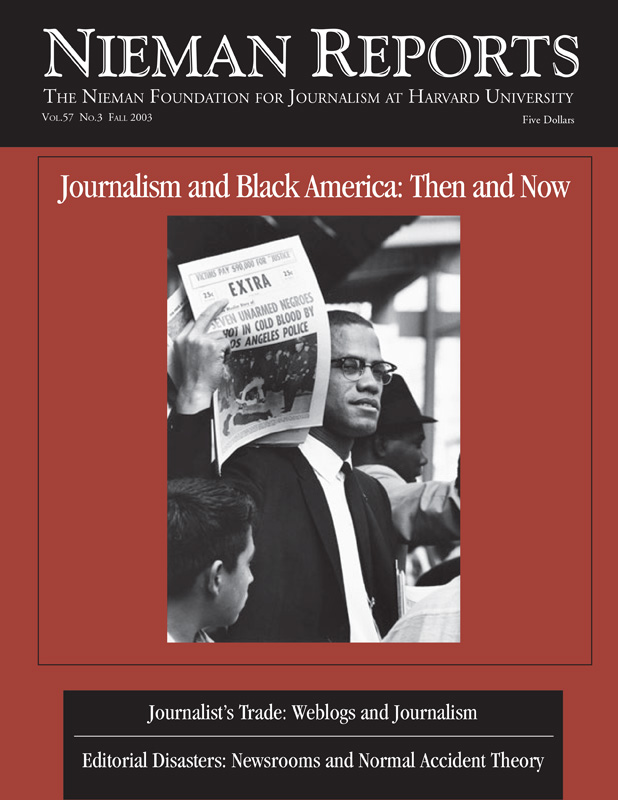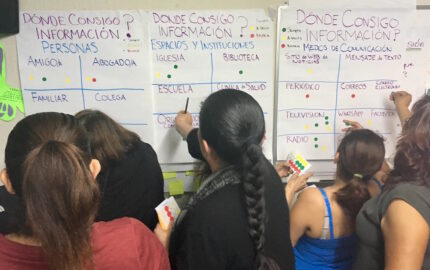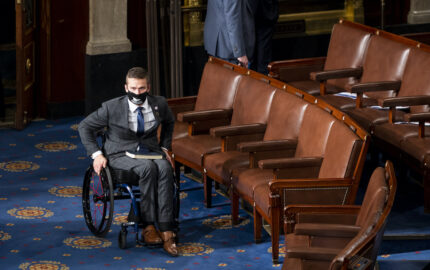
Journalism and Black America: Then and Now
Black and white journalists, at times working as colleagues, at other times separately, have produced the first draft of our nation’s difficult history of race relations. In this issue of Nieman Reports, journalists examine reporting at the intersection of black and white America and look at the racial conditions, climate and conversations in newsrooms. – Melissa Ludtke, Editor
Nearly 30 years ago the news media set out to diversify its ranks. Since then it has more than tripled its number of journalists of color from the recorded low of 3.95 percent. It’s progress, but progress that was far short of its goal to have the nation’s newsrooms reflect the nation’s diversity by the year 2000. According to the annual newsroom census by the American Society of Newspaper Editors (ASNE), journalists of color make up 12.53 percent of the work force. People of color make up 31 percent of the overall population.
There is one often overlooked reason why the industry continues to struggle to retain journalists of color. It is because the news organizations that essentially serve as moderators of the nation’s conversations have yet to learn how to talk about and across their own racial fault lines.
As part of the Maynard Institute’s strategic planning process, we spent the first few months of this year conducting more than 70 interviews with 18 news organizations, most of them newspapers. Armed with a generous grant from the Robert R. McCormick Tribune Foundation, the institute was charged with examining three newsroom issues—diversity, training and the conversation around diversity.
What we found is a conversation fraught with frustration and mistrust. Many people of color are frustrated because they feel as though the industry is failing to live up to its promise. Much of that frustration is borne by the failure to meet the year 2000 goal and then the subsequent decision to push the goal back another 25 years seemingly without making the necessary changes to enable the goal to be better met in the future. Many executives are frustrated because they feel they receive no credit for the progress made. Many white men expressed frustration because they are scared that if they say the wrong thing they will be branded a racist.
Years of compliance training, diversity training, and sensitivity training have taught participants what they can say, and this has essentially left people with a set of learned responses that don’t take this conversation past predictable roadblocks. Little has been done to teach people how to say what they want to say in a way that can be heard and is effective. The result is that even in news organizations that have a diverse staff, the strengths of that diversity are often not reflected in either the content or the business practices. The reason: So many employees have been trained to say what they think they should say and not necessarily what they believe.
Greg Freeman, the late St. Louis (Mo.) Post-Dispatch columnist, said in “To Whom It May Concern,” a book about retaining journalists of color assembled by ASNE: “From talking with colleagues from across the country, I feel that many journalists feel that they aren’t listened to by management in terms of stories and angles. Angles that are perhaps different are often summarily dismissed because they don’t always fit the mold of what some managers think stories should be.”
Because of this, many journalists of color stop offering ideas that they know cut against the grain. Over time, a lot of them decide to leave journalism, according to a 2001 study done for ASNE. The study, brought together by Princeton University researcher Lawrence T. McGill, a meta-analysis of 13 studies looking at the retention of journalists of color between the years 1989 and 2000, cited the lack of professional opportunities and absence of opportunity for career advancement as two of the main reasons journalists of color make the decision to leave.
Trying to Talk Across Race
During one newsroom-wide conversation we had during the institute’s assessment, there was debate about whether this lack of opportunity existed because white managers overlooked journalists of color or because journalists of color did not put their hands up. The discussion was a good illustration of the breakdown in communication across race that is apparent in many newsrooms.
It should not be surprising that journalists do not know how to talk across race. Little in most people’s experience prepares them for these conversations. Most of us grew up (and now live) in mostly segregated communities, attended schools lacking in a diverse student body, and go to segregated houses of worship. Rarely are we in situations that give us the experience and knowledge about how to talk across race. In one community the lack of contact among the races was so apparent that, in an attempt to bring some diversity to his church, an African-American Louisiana Baptist bishop recently offered white people $5 to attend a Sunday service and $10 to attend a Thursday service. When asked why, Bishop Fred Caldwell told CNN, “So let’s just cut to the chase. America needs to come together ….”
While the bishop’s approach is unique, it is equally clear that in our news organizations we need to find ways to at least talk together, if not work well together, if we want to survive as an industry.
What makes this conversation more difficult is that we have yet to acknowledge and understand the role that race and gender play in shaping our perceptions of news and events around us. Just as journalists of color and their white peers experience industry opportunities very differently, they also often view news events through very different lenses.
News coverage of Jayson Blair’s situation at The New York Times offers an example. For many white journalists, race and diversity efforts were at the core of the story. In The Washington Post, syndicated columnist Richard Cohen wrote: “Not only was Blair not stopped, he was promoted to the national staff and ultimately given more responsibilities. Why? The answer appears to be precisely what the Times denies: favoritism based on race.”
Many journalists of color saw the story differently, regarding what happened as a failure of management. “Over the years, the Times has rejected the notion that it needs an ombudsman and has insisted that its editors are capable of detecting errors, enforcing a code of ethics, and addressing issues of credibility raised by its readers. The Jayson Blair affair should be enough for the Times to rethink that conclusion,” wrote (New York) Daily News columnist E.R. Shipp in an article she wrote for the “Outlook” section of The Washington Post.
The Siegal Committee report, a comprehensive examination of the events and practices that led to the departure of the Times’s top editors, Howell Raines and Gerald Boyd, makes it clear both race and management played a role. This is not because Blair was given a break due to his race, but because those who work in newsrooms often shy away from discussions involving race. Jonathan Landman, whose urgent memo noted the need to stop Blair from writing for the Times, said he did not aggressively block Blair’s promotion to the full-time staff in part because the issue of race was involved.
“The racial dimension of this issue and Gerald’s [Boyd] obvious strong feelings made it especially sensitive; in that sense it is fair to say that I backed off a bit more than I would have if race had not been a factor,” Landman says in the Siegal report.
Landman’s experience in shying away from such discussions involving race is common. The fear of saying the wrong thing, appearing racist, or just sounding stupid is so great that some of the white men who participated in our assessment observed that it interfered with the newsroom’s ability to gather good stories and mentor and criticize across racial lines. People of color told of times they found good stories on their beats only to have their news judgment questioned by a white editor. After a while, many said, they stopped going to their editors with such stories. At the same time, white editors have been heard to complain that despite having a diverse staff, all journalists think the same way.
To fulfill the industry’s promise to diversify its newsrooms so journalists can accurately and fairly cover our increasingly complex communities, we need to find ways to talk across our nation’s racial fault lines. To do so might require retraining ourselves in how to listen and how to speak honestly and respectfully to our colleagues. If we fail to learn how to do this, we stand a good chance of having these same stilted and unproductive conversations about how we once again missed the mark in the year 2025.
Dori J. Maynard, a 1993 Nieman Fellow, is president of the Robert C. Maynard Institute for Journalism Education, a 26-year-old nonprofit dedicated to helping the news media reflect the nation’s diversity in staffing, content and business operations.
There is one often overlooked reason why the industry continues to struggle to retain journalists of color. It is because the news organizations that essentially serve as moderators of the nation’s conversations have yet to learn how to talk about and across their own racial fault lines.
As part of the Maynard Institute’s strategic planning process, we spent the first few months of this year conducting more than 70 interviews with 18 news organizations, most of them newspapers. Armed with a generous grant from the Robert R. McCormick Tribune Foundation, the institute was charged with examining three newsroom issues—diversity, training and the conversation around diversity.
What we found is a conversation fraught with frustration and mistrust. Many people of color are frustrated because they feel as though the industry is failing to live up to its promise. Much of that frustration is borne by the failure to meet the year 2000 goal and then the subsequent decision to push the goal back another 25 years seemingly without making the necessary changes to enable the goal to be better met in the future. Many executives are frustrated because they feel they receive no credit for the progress made. Many white men expressed frustration because they are scared that if they say the wrong thing they will be branded a racist.
Years of compliance training, diversity training, and sensitivity training have taught participants what they can say, and this has essentially left people with a set of learned responses that don’t take this conversation past predictable roadblocks. Little has been done to teach people how to say what they want to say in a way that can be heard and is effective. The result is that even in news organizations that have a diverse staff, the strengths of that diversity are often not reflected in either the content or the business practices. The reason: So many employees have been trained to say what they think they should say and not necessarily what they believe.
Greg Freeman, the late St. Louis (Mo.) Post-Dispatch columnist, said in “To Whom It May Concern,” a book about retaining journalists of color assembled by ASNE: “From talking with colleagues from across the country, I feel that many journalists feel that they aren’t listened to by management in terms of stories and angles. Angles that are perhaps different are often summarily dismissed because they don’t always fit the mold of what some managers think stories should be.”
Because of this, many journalists of color stop offering ideas that they know cut against the grain. Over time, a lot of them decide to leave journalism, according to a 2001 study done for ASNE. The study, brought together by Princeton University researcher Lawrence T. McGill, a meta-analysis of 13 studies looking at the retention of journalists of color between the years 1989 and 2000, cited the lack of professional opportunities and absence of opportunity for career advancement as two of the main reasons journalists of color make the decision to leave.
Trying to Talk Across Race
During one newsroom-wide conversation we had during the institute’s assessment, there was debate about whether this lack of opportunity existed because white managers overlooked journalists of color or because journalists of color did not put their hands up. The discussion was a good illustration of the breakdown in communication across race that is apparent in many newsrooms.
It should not be surprising that journalists do not know how to talk across race. Little in most people’s experience prepares them for these conversations. Most of us grew up (and now live) in mostly segregated communities, attended schools lacking in a diverse student body, and go to segregated houses of worship. Rarely are we in situations that give us the experience and knowledge about how to talk across race. In one community the lack of contact among the races was so apparent that, in an attempt to bring some diversity to his church, an African-American Louisiana Baptist bishop recently offered white people $5 to attend a Sunday service and $10 to attend a Thursday service. When asked why, Bishop Fred Caldwell told CNN, “So let’s just cut to the chase. America needs to come together ….”
While the bishop’s approach is unique, it is equally clear that in our news organizations we need to find ways to at least talk together, if not work well together, if we want to survive as an industry.
What makes this conversation more difficult is that we have yet to acknowledge and understand the role that race and gender play in shaping our perceptions of news and events around us. Just as journalists of color and their white peers experience industry opportunities very differently, they also often view news events through very different lenses.
News coverage of Jayson Blair’s situation at The New York Times offers an example. For many white journalists, race and diversity efforts were at the core of the story. In The Washington Post, syndicated columnist Richard Cohen wrote: “Not only was Blair not stopped, he was promoted to the national staff and ultimately given more responsibilities. Why? The answer appears to be precisely what the Times denies: favoritism based on race.”
Many journalists of color saw the story differently, regarding what happened as a failure of management. “Over the years, the Times has rejected the notion that it needs an ombudsman and has insisted that its editors are capable of detecting errors, enforcing a code of ethics, and addressing issues of credibility raised by its readers. The Jayson Blair affair should be enough for the Times to rethink that conclusion,” wrote (New York) Daily News columnist E.R. Shipp in an article she wrote for the “Outlook” section of The Washington Post.
The Siegal Committee report, a comprehensive examination of the events and practices that led to the departure of the Times’s top editors, Howell Raines and Gerald Boyd, makes it clear both race and management played a role. This is not because Blair was given a break due to his race, but because those who work in newsrooms often shy away from discussions involving race. Jonathan Landman, whose urgent memo noted the need to stop Blair from writing for the Times, said he did not aggressively block Blair’s promotion to the full-time staff in part because the issue of race was involved.
“The racial dimension of this issue and Gerald’s [Boyd] obvious strong feelings made it especially sensitive; in that sense it is fair to say that I backed off a bit more than I would have if race had not been a factor,” Landman says in the Siegal report.
Landman’s experience in shying away from such discussions involving race is common. The fear of saying the wrong thing, appearing racist, or just sounding stupid is so great that some of the white men who participated in our assessment observed that it interfered with the newsroom’s ability to gather good stories and mentor and criticize across racial lines. People of color told of times they found good stories on their beats only to have their news judgment questioned by a white editor. After a while, many said, they stopped going to their editors with such stories. At the same time, white editors have been heard to complain that despite having a diverse staff, all journalists think the same way.
To fulfill the industry’s promise to diversify its newsrooms so journalists can accurately and fairly cover our increasingly complex communities, we need to find ways to talk across our nation’s racial fault lines. To do so might require retraining ourselves in how to listen and how to speak honestly and respectfully to our colleagues. If we fail to learn how to do this, we stand a good chance of having these same stilted and unproductive conversations about how we once again missed the mark in the year 2025.
Dori J. Maynard, a 1993 Nieman Fellow, is president of the Robert C. Maynard Institute for Journalism Education, a 26-year-old nonprofit dedicated to helping the news media reflect the nation’s diversity in staffing, content and business operations.


